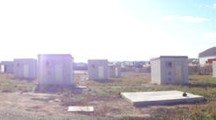The thermal and energy performance of buildings depends on the thermal characteristics of the building envelope and particularly on the thermal resistance of the insulation material used. The ability of a thermal insulation material to transmit heat in the presence of a temperature gradient is determined by its thermal conductivity. The thermal conductivity values of building insulation materials are generally given at 24°C according to ASTM standards. Actually, such a material when used in a building envelope is exposed to significant and continuous temperature changes, essentially due to the changes in outdoor temperature and solar radiation, especially in harsh climate. The main objective of this study is to investigate the relationship between the temperature and the thermal conductivity of polystyrene, which is widely employed as a building insulation material in Oman, at various densities, using the developed experimental setup based on the guarded hot plate method. The results show that higher temperatures lead to higher thermal conductivities and the lower is the material density, the higher is the thermal conductivity. The envelope-induced cooling load for a simple building is also calculated, and it is shown that a lesser cooling load is needed for a high-density insulation.
Similar content being viewed by others
References
A. Ahmed and M. A. Elhadily, Energy conservation measures for a typical detached single family house in Dhahran, in: Proc. 1st Symposium on Energy Conservation and Management in Buildings, King Fahd University of Petroleum and Minerals, Saudi Arabia, February 5–6, 2002, pp. 31–42.
M. A. Abdulrahman and A. Ahmad, Cost effective use of thermal insulation in hot climates, J. Build. Environ., 26, No. 2, 189–194 (1991).
ASHRAE Handbook–Fundamentals, Atlanta, GA (2001), Ch. 23.
B. A. Peavey, A heat transfer note on temperature dependent thermal conductivity, J. Therm. Insul. Build. Envelopes, 20, 79–90 (1996).
F. Dominguez-Munoz, B. Anderson, J. Cejudo-Lopez, and A. Carrillo-Andres, Uncertainty in the thermal conductivity of insulation materials, in: Proc. Eleventh Int. IBPSA Conf., Glasgow, Scotland, July 27–30, 2009.
M. Khoukhi and M. Tahat, Effect of operating temperatures on thermal conductivity of polystyrene insulation material: Impact on envelope-induced cooling load, in: Proc. Int. Conf. on Advances in Mechanical and Manufacturing Engineering, Kuala Lumpur, Malaysia, November 26–28, 2013.
D. F. Aldrich and R. H. Bond, Thermal performance of rigid cellular foam insulation at subfreezing temperature, in: Proc. III ASHRAE/DOE/BTECC Conf. Thermal Performance of Exterior Envelopes of Buildings, Florida, December 2–5, 1985, pp. 500–509.
K. E. Wilkes and P. W. Child, Thermal performance of fiberglass and cellulose attic insulation, in: Proc. V ASHRAE/ DOE/BTECC/CIBSE Conf. Thermal Performance of Exterior Envelopes of Buildings, Florida, December 7–10, 1992, pp. 357–367.
A. Al-Hammad, M. A. Abdelrahman, W. Grondzik, and A. Hawari, A comparison between actual and published k-values for Saudi insulation materials, J. Therm. Insulation Build. Envelopes, 17, 378–385 (1994).
G. S. Kochlar and K. Monahar, Effect of moisture on thermal conductivity of fibers biological insulation materials, in: Proc. VI ASHRAE/DOE Conf. Thermal Performance of Exterior Envelopes of Buildings, Florida, December 2–5, 1995, pp. 33–40.
A. Budawi, A. Abdou, and M. Al-Homoud, Variations of thermal conductivity of insulation materials under different operating temperatures: Impact on envelope-induced cooling load, J. Archit. Eng., 8, No. 4, 125–132 (2002).
Author information
Authors and Affiliations
Corresponding author
Additional information
Published in Inzhenerno-Fizicheskii Zhurnal, Vol. 88, No. 4, pp. 960–964, July–August, 2015.
Rights and permissions
About this article
Cite this article
Khoukhi, M., Tahat, M. Effect of Temperature and Density Variations on Thermal Conductivity of Polystyrene Insulation Materials in Oman Climate. J Eng Phys Thermophy 88, 994–998 (2015). https://doi.org/10.1007/s10891-015-1275-6
Received:
Revised:
Published:
Issue Date:
DOI: https://doi.org/10.1007/s10891-015-1275-6




